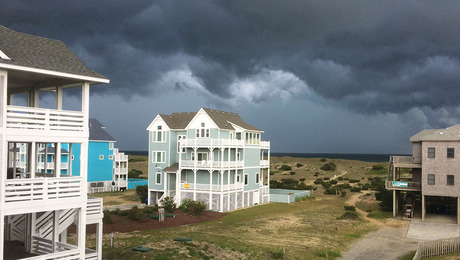I managed to nick a 120 VAC cable while removing sheetrock. What are my repair options. The cable does not end at a J-box so I can’t slip a raychem splice over the wire. Would it be acceptable to just us electrical tape? What does the NEC allow?
Harold















Replies
Did you nick just the outer covering? or the insulation of the individual wire? is the copper conductor exposed?
Sorry for the slow reply. It nicked the individual conductor insulation. It drew a spark.
You exposed the conductor since you drew a spark. So, the correct repair is to splice in a box. Another reason for this is because the copper may be smaller at the point of the arc, so cutting it and installing a wire nut will remove the small area from the circuit.Maybe you need an outlet at this point? Didn't think so! You will need to replace the wire in its entirety or add an outlet or blank j box at a convenient spot.Frank DuVal You can never make something foolproof because fools are so ingenious.
If he doesn't cut the wire it's not a splice.
If he repairs the conductor in situ, does code still require a J-box?SamT
Anyone who doesn't take truth seriously in small matters cannot be trusted in large ones either. [Einstein] Tks, BossHogg.
Well he saw sparks so the wire is compromised. Don't really know how bad, but it is compromised.Now assuming that he did not damage the wire. How is he going to replace the insulation on an individual wire to the same qaulity of orginal.Now on a open end heat shrink could be used. But this is not open.Possibly he could cut the sheathing back 4-6". Then tape the insulation on the wire. Needs to build it up to the orginal thickness and temp rating.Then he needs to repair the sheathing.More tape.And after all of that there is still concern with the tape creeping or drying out..
.
A-holes. Hey every group has to have one. And I have been elected to be the one. I should make that my tagline.
If he repairs the conductor in situ, does code still require a J-box?
Pretty much, yes.
If he has damaged the outer sheath of the NM-B (e.g. Romex), his options are basically:
1. replace the wire
2. Put it in a junction box
3. Run the wire in conduit.
Now, if he has actually nicked the wire (which he said he has), his options are:
1. splice the wire in a junction box (which cannot be concealed)
2. replace the wire
Given the circumstances, I think the best option is to install a junction box and an outlet.
BillHartmann and woodturner9 <!----><!---->
Well he saw sparks so the wire is compromised. Don't really know how bad, but it is compromised.
That can be repaired in place. It does require tape to repair the insulation and jacket.
And after all of that there is still concern with the tape creeping or drying out.
Needs proper taping techniques.
If he has damaged the outer sheath of the NM-B (e.g. Romex), his options are basically:
1. replace the wire
Now, if he has actually nicked the wire (which he said he has), his options are:
1. splice the wire in a junction box (which cannot be concealed)
2. replace the wire
If that's what's required by code, OK, there's no point in going farther with this. Electrically and mechanically speaking the problem can be repaired with some wire and tape and good techniques. Solder would be the suspenders.
I'm not qualified to address the code in this matter, however, in the Navy I learned techniques suitable for MilSpec use.SamT
Anyone who doesn't take truth seriously in small matters cannot be trusted in large ones either. [Einstein] Tks, BossHogg.
SamT,What we mean by compromised is that when sparks were flying, copper was what was seen flying. Therefore the copper is smaller in diameter than originally manufactured. So, what is the new amp rating of the wire at that small point? We don't know. It could be same as manufactured, or it could be half the original size. If it is small and the point just taped up, plug in a space heater later on and you will be back in the wall repairing the now OPEN wire, as at some point the wire will be rated less than the breaker. Of course removing more of the insulation will allow for a closer look to see if the wire is smaller.I do agree with you that certain taping methods, self vulcanizing rubber comes to mind, will be there longer than the romex sheathing. But, most people use the vinyl tape that can peel off in a year. I even come across friction tape junctions that have been in the walls (knob & tube wiring) since the 1910s. Still holding fine.... But only knob & tube was ever allowed to be spliced outside of a box.To others:Yes, to add a box to an existing wire run you usually need to add two boxes, unless you can run a new wire in one direction. If you could run it in both directions, you wouldn't need a splice or new box!Frank DuVal You can never make something foolproof because fools are so ingenious.
What we mean by compromised is that when sparks were flying, copper was what was seen flying. Therefore the copper is smaller in diameter than originally manufactured.
No sheet!?!?!
Well, goooooollee, Sarge.
SamT
Anyone who doesn't take truth seriously in small matters cannot be trusted in large ones either. [Einstein] Tks, BossHogg.
Edited 2/24/2007 12:41 am by SamT
FrankDuVal: Agree with you post, but I don't think that you emphasized that the box can't be concealed. Lots of luck..........................................
"If all else fails, read the directions"
nice info
Mobdro is a free spilling android application, which is allowing us to watch two or three serious TV shows up, TV News and making us to watch general NEWS in this single application so download mobdro app from https://mobdroapk.org/
I've never done this. How do you install an outlet or plug, if you cut the wire at the point it is damaged? You don't end up with enough slack to strip and use connectors - do you use a pigtail?
I think you would need two boxes to do that, one to either side of the defect.
To add an outlet where you have a break, you need to figure out which end is easiest to get to the end of - like the nearest outlet or switchbox. (If neither is easily available, then you will need to add two new boxes). You will add a new length of romex to that accessable box.
You could also just put the box in the attic instead, just as long as it is accessable.Rebuilding my home in Cypress, CA
Also a CRX fanatic!
Ah. Two boxes. I was afraid that would be the only answer. Still curious though. I have been sitting here doodling and can't see how one box could be in an accessible attic above, unless the wire came from there..
It depends on how the electrician ran it. My home was fed primarly from the attic down, then run through the walls. If you nicked it on a horizontal run through the stud bays then two boxes are it. Now, you don't need to face them both the same direction, one could be in the room and the other faced to the opposite wall.Rebuilding my home in Cypress, CA
Also a CRX fanatic!
I managed to nick a 120 VAC cable while removing sheetrock
Just remove more sheet rock to the closest boxes in each direction, and replace the wire that was nicked between them. A little more of what you are aready doing, right?
Dave
Excellent dialogue to all who responded. Thank you. I plan to rewire between the two outlets. There is an outlet one stud away from where I nicked the wire. So I can remove some sheet rock to access the outlet. The other end of the wire goes to another 5 feet away. Unfortunately the wire is run through the studs. It will require removing some sheet rock from this outlet also so I can drill a holel into the sole plate and run so I can rewire this through the basement.
Unfortunately the code does not permit a hidden JB.
Lesson learned be more careful when cutting sheetrock.
Harold
A 14/2 cable runs down a wall where a window will be installed. Can I solder and use shrink insulation for both wires so I can reroute the circuit around the window?
In standard home construction, any and every junction, whether soldered or wire-nutted or whatever, must be inside an accessible box.
How about using one of the Tyco Romex splice kits?
As far as I know those are only legal as factory-installed connections in "manufactured" housing.
Must be getting near Easter again,
aka -- another resurrected post ?
If copper not cut, I've just split a short piece of 1/2" pvc pipe, sanpped it around the wire, and filled with silicone.
Not per code, but perfectly good fix and more reliable than another box plus splices.
Last decent NEC was circa 1980. All the more recent code crap like AFCI and TR outlets is simply forced consumerism for unwanted and unneeded (jobsite word).
That doesn't answer our tennis player's question, as he wants to reroute the wire and needs to splice it.
Of course he can. If Cu is cut, then solder back togeter (or solder in splice extension) and use the PVC pipe and silicone fix.
a ma give an inspector apoplexy, but who's gonna call him. Of course, if ya gotta git a permit, gotta do what the miniomns of teh mfgs want ya to do.
NEC 2014, para 334.40 says you can use them exposed without boxes, or concealled in repair work. I would check with the local inspector before using them of course.
(you can read the NEC online at the NFPA web site: Free registration required)
http://www.nfpa.org/codes-and-standards/document-information-pages?mode=code&code=70